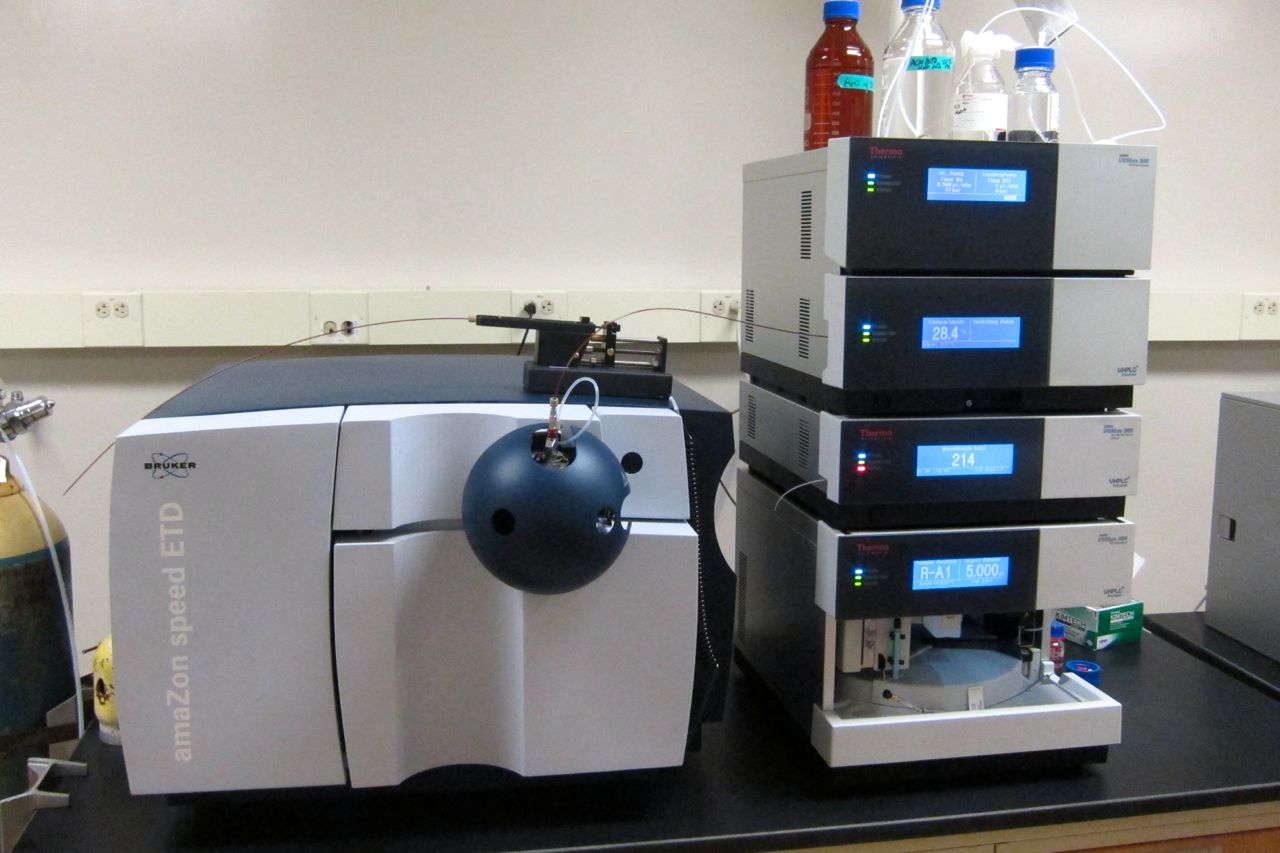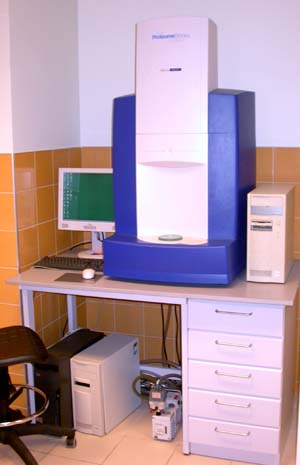|
Orbitrap
In mass spectrometry, Orbitrap is an ion trap mass analyzer consisting of an outer barrel-like electrode and a coaxial inner spindle-like electrode that traps ions in an orbital motion around the spindle. The image current from the trapped ions is detected and converted to a mass spectrum using the Fourier transform of the frequency signal. History The concept of electrostatically trapping ions in an orbit around a central spindle was developed by Kenneth Hay Kingdon in the early 1920s. The Kingdon trap consists of a thin central wire and an outer cylindrical electrode. A static applied voltage results in a radial logarithmic potential between the electrodes. In 1981, Knight introduced a modified outer electrode that included an axial quadrupole term that confines the ions on the trap axis. Neither the Kingdon nor the Knight configurations were reported to produce mass spectra. The invention of the Orbitrap analyzer and its proof-of-principle by Makarov at the end of the 1990s ... [...More Info...] [...Related Items...] OR: [Wikipedia] [Google] [Baidu] |
Linear Ion Trap
The linear ion trap (LIT) is a type of ion trap mass spectrometer. In a LIT, ions are confined radially by a two-dimensional radio frequency (RF) field, and axially by stopping potentials applied to end electrodes. LITs have high injection efficiencies and high ion storage capacities. History One of the first LITs was constructed in 1969, by Dierdre A. Church, who bent linear quadrupoles into closed circle and racetrack geometries and demonstrated storage of 3 He+ and H+ ions for several minutes. Earlier, Drees and Paul described a circular quadrupole. However, it was used to produce and confine a plasma, not to store ions. In 1989, Prestage, Dick, and Malecki described that ions could be trapped in the linear quadrupole trap system to enhance ion-molecule reactions, thus it can be used to study spectroscopy of stored ions. How it works The LIT uses a set of quadrupole rods to confine ions radially and a static electrical potential on the end electrodes to confine the ion ... [...More Info...] [...Related Items...] OR: [Wikipedia] [Google] [Baidu] |
Ion Trap
An ion trap is a combination of electric and/or magnetic fields used to capture charged particles — known as ions — often in a system isolated from an external environment. Atomic and molecular ion traps have a number of applications in physics and chemistry such as precision mass spectrometry, improved atomic frequency standards, and quantum computing. In comparison to neutral atom traps, ion traps have deeper trapping potentials (up to several electronvolts) that do not depend on the internal electronic structure of a trapped ion. This makes ion traps more suitable for the study of light interactions with single atomic systems. The two most popular types of ion traps are the Penning trap, which forms a potential via a combination of static electric and magnetic fields, and the Paul trap which forms a potential via a combination of static and oscillating electric fields. Penning traps can be used for precise magnetic measurements in spectroscopy. Studies of quantum state ... [...More Info...] [...Related Items...] OR: [Wikipedia] [Google] [Baidu] |
Metabolomics
Metabolomics is the scientific study of chemical processes involving metabolites, the small molecule substrates, intermediates, and products of cell metabolism. Specifically, metabolomics is the "systematic study of the unique chemical fingerprints that specific cellular processes leave behind", the study of their small-molecule metabolite profiles. The metabolome represents the complete set of metabolites in a biological cell, tissue, organ, or organism, which are the end products of cellular processes. Messenger RNA (mRNA), gene expression data, and proteomics, proteomic analyses reveal the set of gene products being produced in the cell, data that represents one aspect of cellular function. Conversely, metabolic profiling can give an instantaneous snapshot of the physiology of that cell, and thus, metabolomics provides a direct "functional readout of the physiological state" of an organism. There are indeed quantifiable correlations between the metabolome and the other cellular ... [...More Info...] [...Related Items...] OR: [Wikipedia] [Google] [Baidu] |
Orbitrap Mass Analyzers
In mass spectrometry, Orbitrap is an ion trap mass analyzer consisting of an outer barrel-like electrode and a coaxial inner spindle-like electrode that traps ions in an orbital motion around the spindle. The image current from the trapped ions is detected and converted to a mass spectrum using the Fourier transform of the frequency signal. History The concept of electrostatically trapping ions in an orbit around a central spindle was developed by Kenneth Hay Kingdon in the early 1920s. The Kingdon trap consists of a thin central wire and an outer cylindrical electrode. A static applied voltage results in a radial logarithmic potential between the electrodes. In 1981, Knight introduced a modified outer electrode that included an axial quadrupole term that confines the ions on the trap axis. Neither the Kingdon nor the Knight configurations were reported to produce mass spectra. The invention of the Orbitrap analyzer and its proof-of-principle by Makarov at the end of the 1990s sta ... [...More Info...] [...Related Items...] OR: [Wikipedia] [Google] [Baidu] |
Electron-transfer Dissociation
Electron-transfer dissociation (ETD) is a method of fragmenting multiply-charged gaseous macromolecules in a mass spectrometer between the stages of tandem mass spectrometry (MS/MS). Similar to electron-capture dissociation, ETD induces fragmentation of large, multiply-charged cations by transferring electrons to them. ETD is used extensively with polymers and biological molecules such as proteins and peptides for sequence analysis. Transferring an electron causes peptide backbone cleavage into c- and z-ions while leaving labile post translational modifications (PTM) intact. The technique only works well for higher charge state peptide or polymer ions (z>2). However, relative to collision-induced dissociation (CID), ETD is advantageous for the fragmentation of longer peptides or even entire proteins. This makes the technique important for top-down proteomics. The method was developed by Hunt and coworkers at the University of Virginia. History Electron-capture dissociation ... [...More Info...] [...Related Items...] OR: [Wikipedia] [Google] [Baidu] |
Kingdon Trap
An ion trap is a combination of electric and/or magnetic fields used to capture charged particles — known as ions — often in a system isolated from an external environment. Atomic and molecular ion traps have a number of applications in physics and chemistry such as precision mass spectrometry, improved atomic frequency standards, and quantum computing. In comparison to neutral atom traps, ion traps have deeper trapping potentials (up to several electronvolts) that do not depend on the internal electronic structure of a trapped ion. This makes ion traps more suitable for the study of light interactions with single atomic systems. The two most popular types of ion traps are the Penning trap, which forms a potential via a combination of static electric and magnetic fields, and the Paul trap which forms a potential via a combination of static and oscillating electric fields. Penning traps can be used for precise magnetic measurements in spectroscopy. Studies of quantum state ma ... [...More Info...] [...Related Items...] OR: [Wikipedia] [Google] [Baidu] |
MALDI
In mass spectrometry, matrix-assisted laser desorption/ionization (MALDI) is an ionization technique that uses a laser energy absorbing matrix to create ions from large molecules with minimal fragmentation. It has been applied to the analysis of biomolecules (biopolymers such as DNA, proteins, peptides and carbohydrates) and various organic molecules (such as polymers, dendrimers and other macromolecules), which tend to be fragile and fragment when ionized by more conventional ionization methods. It is similar in character to electrospray ionization (ESI) in that both techniques are relatively soft (low fragmentation) ways of obtaining ions of large molecules in the gas phase, though MALDI typically produces far fewer multi-charged ions. MALDI methodology is a three-step process. First, the sample is mixed with a suitable matrix material and applied to a metal plate. Second, a pulsed laser irradiates the sample, triggering ablation and desorption of the sample and matrix mater ... [...More Info...] [...Related Items...] OR: [Wikipedia] [Google] [Baidu] |
Fourier-transform Ion Cyclotron Resonance
Fourier-transform ion cyclotron resonance mass spectrometry is a type of mass analyzer (or mass spectrometer) for determining the mass-to-charge ratio (''m''/''z'') of ions based on the cyclotron frequency of the ions in a fixed magnetic field. The ions are trapped in a Penning trap (a magnetic field with electric trapping plates), where they are excited (at their resonant cyclotron frequencies) to a larger cyclotron radius by an oscillating electric field orthogonal to the magnetic field. After the excitation field is removed, the ions are rotating at their cyclotron frequency in phase (as a "packet" of ions). These ions induce a charge (detected as an image current) on a pair of electrodes as the packets of ions pass close to them. The resulting signal is called a free induction decay (FID), transient or interferogram that consists of a superposition of sine waves. The useful signal is extracted from this data by performing a Fourier transform to give a mass spectrum. History FT ... [...More Info...] [...Related Items...] OR: [Wikipedia] [Google] [Baidu] |
Resolution (mass Spectrometry)
In mass spectrometry, resolution is a measure of the ability to distinguish two peaks of slightly different mass-to-charge ratios ''ΔM'', in a mass spectrum. Resolution and resolving power There are two different definitions of resolution and resolving power in mass spectrometry. IUPAC definition The IUPAC definition for resolution in mass spectrometry is :R = \cfrac = \mathrm :\Delta M = \mathrm :M = \mathrm Where a larger resolution indicates a better separation of peaks. This definition is used in a number of mass spectrometry texts. This use is also implied by the term "high-resolution mass spectrometry." A high value for resolution corresponding to good separation of peaks is similar to the convention used with chromatography separations, although it is important to note that the definitions are not the same. High resolution indicating better peak separation is also used in ion mobility spectrometry. Resolving power definition Some mass spectrometrists use the def ... [...More Info...] [...Related Items...] OR: [Wikipedia] [Google] [Baidu] |
Quadrupole
A quadrupole or quadrapole is one of a sequence of configurations of things like electric charge or current, or gravitational mass that can exist in ideal form, but it is usually just part of a multipole expansion of a more complex structure reflecting various orders of complexity. Mathematical definition The quadrupole moment tensor ''Q'' is a rank-two tensor—3×3 matrix. There are several definitions, but it is normally stated in the traceless form (i.e. Q_ + Q_ + Q_ = 0). The quadrupole moment tensor has thus nine components, but because of transposition symmetry and zero-trace property, in this form only five of these are independent. For a discrete system of \ell point charges or masses in the case of a gravitational quadrupole, each with charge q_\ell, or mass m_\ell, and position \vec_\ell = \left(r_, r_, r_\right) relative to the coordinate system origin, the components of the ''Q'' matrix are defined by: : Q_ = \sum_\ell q_\ell\left(3r_ r_ - \left\, \vec_\ell \ri ... [...More Info...] [...Related Items...] OR: [Wikipedia] [Google] [Baidu] |

.jpg)


